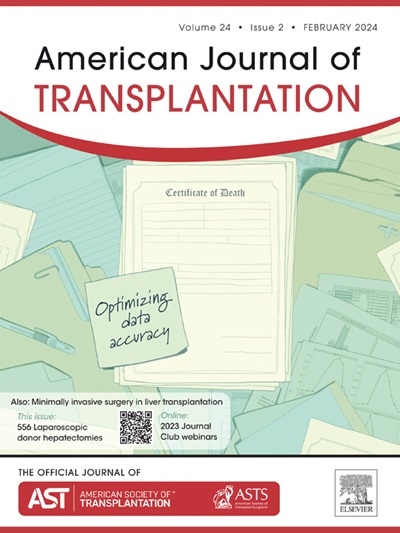Effects of race-neutral estimated glomerular filtration rate policies on access to kidney transplantation.
IF 8.2
2区 医学
Q1 SURGERY
引用次数: 0
Abstract
Motivated by potential inequities in access to transplantation stemming from the inclusion of Black race coefficients in estimated Glomerular Filtration Rate (eGFR) formulas, the United States Organ Procurement and Transplant Network (OPTN) implemented policies in 2022 and 2023 mandating the use of race-neutral eGFR formulas and the modification of waiting times for Black patients. We evaluated the impact of these policies on access to kidney transplantation using national registry data and supplementary OPTN data describing all waiting time modifications. The policy effects were assessed through segmented regression and difference-in-difference frameworks. There were no meaningful changes from the first mandate in the odds of a preemptively waitlisted patient being Black. The second mandate was associated with 3.8 [95% Confidence Interval: (2.7, 4.9), p-value < 0.001] additional deceased donor transplants per one-hundred person-years among the overall Black population, but 6.0 [95% Confidence Interval: (4.7, 7.3), p-value < 0.001] fewer deceased donor transplants per one-hundred person-years among the Black patients who did not receive waiting time modifications. There was evidence that the OPTN's second mandate had a positive impact on deceased donor transplant rates in the overall Black population but a negative impact on Black patients who did not receive additional waiting time.种族中立估计肾小球滤过率政策对肾移植可及性的影响。
由于估计肾小球滤过率(eGFR)公式中包含黑人种族系数,因此在获得移植方面存在潜在的不公平,美国器官采购和移植网络(OPTN)在2022年和2023年实施了政策,要求使用种族中立的eGFR公式,并修改黑人患者的等待时间。我们使用国家登记数据和描述所有等待时间修改的补充OPTN数据来评估这些政策对获得肾移植的影响。通过分段回归和差中差框架评估政策效果。与第一次授权相比,优先等待的黑人患者的几率没有重大变化。在第二项研究中,在整个黑人人群中,每百人年增加3.8例[95%置信区间:(2.7,4.9),p值< 0.001]死亡供体移植,但在未接受等待时间修改的黑人患者中,每百人年减少6.0例[95%置信区间:(4.7,7.3),p值< 0.001]死亡供体移植。有证据表明,OPTN的第二项任务对整个黑人人口的已故供体移植率产生了积极影响,但对没有获得额外等待时间的黑人患者产生了负面影响。
本文章由计算机程序翻译,如有差异,请以英文原文为准。
求助全文
约1分钟内获得全文
求助全文
来源期刊
CiteScore
18.70
自引率
4.50%
发文量
346
审稿时长
26 days
期刊介绍:
The American Journal of Transplantation is a leading journal in the field of transplantation. It serves as a forum for debate and reassessment, an agent of change, and a major platform for promoting understanding, improving results, and advancing science. Published monthly, it provides an essential resource for researchers and clinicians worldwide.
The journal publishes original articles, case reports, invited reviews, letters to the editor, critical reviews, news features, consensus documents, and guidelines over 12 issues a year. It covers all major subject areas in transplantation, including thoracic (heart, lung), abdominal (kidney, liver, pancreas, islets), tissue and stem cell transplantation, organ and tissue donation and preservation, tissue injury, repair, inflammation, and aging, histocompatibility, drugs and pharmacology, graft survival, and prevention of graft dysfunction and failure. It also explores ethical and social issues in the field.

 求助内容:
求助内容: 应助结果提醒方式:
应助结果提醒方式:


